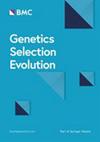基因型与高维环境数据的环境相互作用:以猪为例
IF 3.1
1区 农林科学
Q1 AGRICULTURE, DAIRY & ANIMAL SCIENCE
引用次数: 0
摘要
在传统的遗传预测模型中,环境通常被视为不相关的影响,要么是固定的,要么是随机的。当它们共享相同的位置、管理实践或气候条件时,环境可以相互关联。温度-湿度指数(THI)通常用于解决与气候或热应激有关的环境影响。然而,它并不能完全描述一个特定地点的完整气候剖面。因此,在可用的情况下,使用多个环境协变量(ECs)来描述特定环境中的天气是更合适的。这就提出了一个问题,即公开可用的天气信息(如NASA POWER)是否对基因组预测有用。基因型-环境相互作用(GxE)可以用多性状模型或反应规范来建模。但是,前者需要每个环境大量的记录,而后者在ec数量很大时可能导致模型参数化过度。本研究调查了在纯种猪生产性状的基因组预测中,使用ECs是否是一种合适的策略来关联环境(畜群)和建模GxE。我们评估了不同的模型来解释环境影响和GxE。当基于ECs的环境相关性时,我们观察到环境方差的增加,伴随着表型方差的增加和遗传力的降低。此外,将环境作为一种不相关的随机效应,与根据天气信息将其作为相关因素处理,在估计育种值时产生了同样的准确性。所有被测试的模型都显示出相同的偏差,但多性状模型的预测是不分散的。两种性状均存在GxE;然而,与平均日增重相比,背膘厚度与基因无关的环境更多。使用室外天气信息来关联环境和模型GxE对猪的基因组预测提供有限的优势。虽然它增加了模型的复杂性,增加了计算时间,但没有提高精度,但它确实增强了模型拟合。将环境信息(如羊群效应)作为不相关的随机效应纳入模型有助于解决GxE和环境效应。本文章由计算机程序翻译,如有差异,请以英文原文为准。
Genotype-by-environment interaction with high-dimensional environmental data: an example in pigs
In traditional genetic prediction models, environments are typically treated as uncorrelated effects, either fixed or random. Environments can be correlated when they share the same location, management practices, or climate conditions. The temperature-humidity index (THI) is often used to address environmental effects related to climate or heat stress. However, it does not fully describe the complete climate profile of a specific location. Therefore, it is more appropriate to use multiple environmental covariates (ECs), when available, to describe the weather in a specific environment. This raises the question of whether publicly available weather information (such as NASA POWER) is useful for genomic predictions. Genotype-by-environment interaction (GxE) can be modeled using multiple-trait models or reaction norms. However, the former requires a substantial number of records per environment, while the latter can result in over-parametrized models when the number of ECs is large. This study investigated whether using ECs is a suitable strategy to correlate environments (herds) and to model GxE in the genomic prediction of purebred pigs for production traits. We evaluated different models to account for environmental effects and GxE. When environments were correlated based on ECs, we observed an increase in environmental variance, which was accompanied by an increase in phenotypic variance and a decrease in heritability. Furthermore, including environments as an uncorrelated random effect yielded the same accuracy of estimated breeding values as treating them as correlated based on weather information. All the tested models exhibited the same bias, but the predictions from the multiple-trait models were under-dispersed. Evidence of GxE was observed for both traits; however, there were more genetically unconnected environments for backfat thickness than for average daily gain. Using outdoor weather information to correlate environments and model GxE offers limited advantages for genomic predictions in pigs. Although it adds complexity to the model and increases computing time without improving accuracy, it does enhance model fit. Including environment information (e.g. herd effect) as an uncorrelated random effect in the model could help address GxE and environmental effects.
求助全文
通过发布文献求助,成功后即可免费获取论文全文。
去求助
来源期刊

Genetics Selection Evolution
生物-奶制品与动物科学
CiteScore
6.50
自引率
9.80%
发文量
74
审稿时长
1 months
期刊介绍:
Genetics Selection Evolution invites basic, applied and methodological content that will aid the current understanding and the utilization of genetic variability in domestic animal species. Although the focus is on domestic animal species, research on other species is invited if it contributes to the understanding of the use of genetic variability in domestic animals. Genetics Selection Evolution publishes results from all levels of study, from the gene to the quantitative trait, from the individual to the population, the breed or the species. Contributions concerning both the biological approach, from molecular genetics to quantitative genetics, as well as the mathematical approach, from population genetics to statistics, are welcome. Specific areas of interest include but are not limited to: gene and QTL identification, mapping and characterization, analysis of new phenotypes, high-throughput SNP data analysis, functional genomics, cytogenetics, genetic diversity of populations and breeds, genetic evaluation, applied and experimental selection, genomic selection, selection efficiency, and statistical methodology for the genetic analysis of phenotypes with quantitative and mixed inheritance.
 求助内容:
求助内容: 应助结果提醒方式:
应助结果提醒方式:


